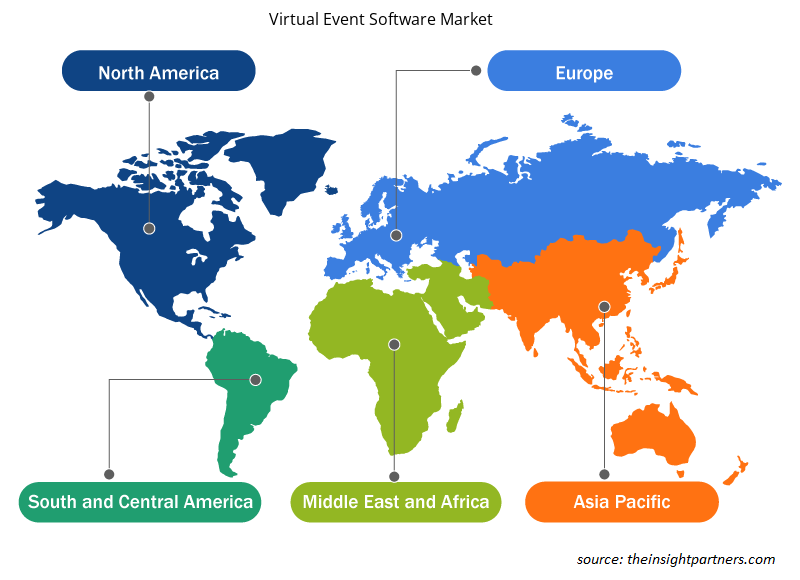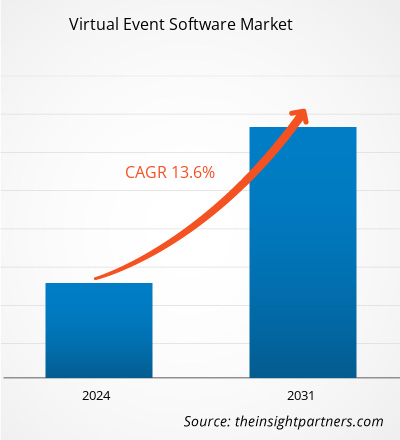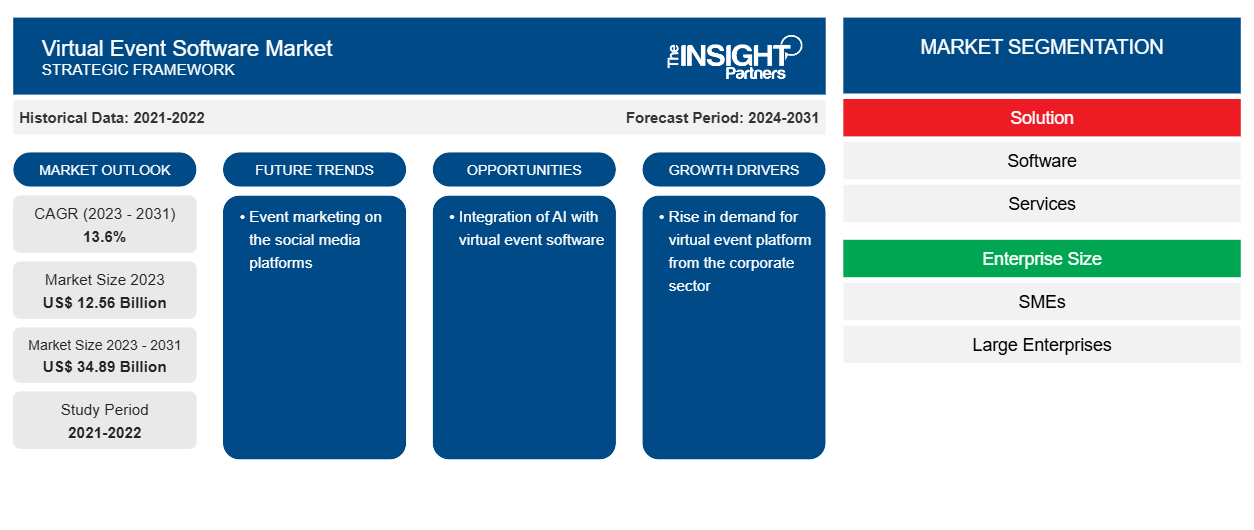Se prevé que el tamaño del mercado de software para eventos virtuales alcance los 34.890 millones de dólares en 2031, frente a los 12.560 millones de dólares en 2023. Se espera que el mercado registre una CAGR del 13,6 % durante el período 2023-2031. Es probable que el crecimiento de los eventos virtuales y el aumento de la adopción de plataformas de eventos virtuales basadas en IA sigan siendo tendencias clave en el mercado.
Análisis del mercado de software para eventos virtuales
El software para eventos virtuales está ganando terreno debido a factores como la creciente penetración de Internet, el aumento de la digitalización y el impulso de la cultura del trabajo desde casa en el sector corporativo. La capacidad del software para eventos virtuales de involucrar a los asistentes con diversas funciones atractivas, como la interacción uno a uno, encuestas de preguntas y respuestas, chats en vivo, emoticones y otras, impulsa su demanda entre varios usuarios finales, como empresas, empresas de gestión de eventos, organizadores de ferias comerciales, instituciones académicas y otros.
Descripción general del mercado de software para eventos virtuales
El software de eventos virtuales ayuda a realizar eventos de manera virtual y eficiente. Presenta las mismas características que el software de gestión de eventos. La única diferencia es que el software de gestión de eventos también incluye la gestión del evento en persona. El software de eventos virtuales tiene capacidades como la transmisión web y se integra perfectamente con el software de seminarios web. Puede integrar contenido interactivo como chats grupales, encuestas de preguntas y respuestas y redes sociales . El usuario también puede asistir al evento desde cualquier dispositivo.
Personalice este informe según sus necesidades
Obtendrá personalización en cualquier informe, sin cargo, incluidas partes de este informe o análisis a nivel de país, paquete de datos de Excel, así como también grandes ofertas y descuentos para empresas emergentes y universidades.
-
Obtenga las principales tendencias clave del mercado de este informe.Esta muestra GRATUITA incluirá análisis de datos, desde tendencias del mercado hasta estimaciones y pronósticos.
Factores impulsores y oportunidades del mercado del software para eventos virtuales
Aumento de la demanda de plataformas de eventos virtuales por parte del sector corporativo para favorecer al mercado
El sector corporativo está experimentando la creciente popularidad de las reuniones virtuales, que es uno de los factores clave que impulsan la necesidad de una plataforma de eventos virtuales. La ola de transformación digital, la pandemia de COVID-19 y la cultura del trabajo desde casa en el sector corporativo han generado la necesidad de una solución para involucrar a los empleados y las partes interesadas de la empresa en una única plataforma integrada. Las grandes corporaciones tienen a sus empleados en todo el mundo. Para las actividades de consolidación de equipos, la corporación organiza varios eventos en los que sus empleados pueden participar. El evento de consolidación de equipos ayuda a las corporaciones a crear un equipo de alto rendimiento y desarrollar un espacio para los empleados donde pueden interactuar y conocer más sobre los diversos antecedentes y experiencias de los demás. Por lo tanto, las corporaciones organizan eventos para crear un ambiente de trabajo saludable y relaciones con los empleados, lo que impulsa aún más su productividad en el trabajo.
Integración de IA con software de eventos virtuales
Las tecnologías integradas con IA ayudan al usuario a detectar patrones y conocimientos para descubrir las brechas y oportunidades que mejoran las características de cualquier software y proceso. El software de eventos virtuales integrado con IA puede ayudar a crear automáticamente las agendas de eventos y la planificación automática de eventos. Puede personalizar lugares y stands virtuales. También ayuda a replicar la experiencia en persona en las plataformas virtuales. Algunos actores del mercado ofrecen plataformas de eventos virtuales basadas en IA. Por ejemplo, EventsX es una plataforma impulsada por IA para organizar, comercializar y albergar el evento virtual, híbrido o en persona perfecto. Proporciona análisis en tiempo real y posteriores al evento que ayudan a los usuarios a comprender las experiencias de los clientes. El análisis de eventos también los ayuda a mejorar para un evento futuro al mejorar las experiencias personalizadas de los clientes.
Análisis de segmentación del informe de mercado de software de eventos virtuales
Los segmentos clave que contribuyeron a la derivación del análisis del mercado de software de eventos virtuales son la solución, el tamaño de la empresa y el usuario final.
- Según la solución, el mercado de software para eventos virtuales se divide en software y servicios. El segmento de software tuvo la mayor participación del mercado en 2023.
- Por tamaño de empresa, el mercado se segmenta en pymes y grandes empresas. Se espera que las pymes crezcan con la CAGR más alta durante el período de pronóstico.
- En términos de usuario final, el mercado está segmentado en organizadores de ferias comerciales, agencias de gestión de eventos, empresas, organizaciones académicas y otros. Se espera que el segmento corporativo crezca con una CAGR significativa.
Análisis de la cuota de mercado del software de eventos virtuales por geografía
El alcance geográfico del informe del mercado de software de eventos virtuales se divide principalmente en cinco regiones: América del Norte, Asia Pacífico, Europa, Medio Oriente y África, y América del Sur y Central.
Se espera que la región de Asia Pacífico crezca con la CAGR más alta durante el período de pronóstico. La creciente digitalización, el crecimiento del sector corporativo y la proliferación de Internet en la región son algunos de los factores que impulsan el mercado de software de eventos virtuales de Asia Pacífico. Varias empresas de software están expandiendo su presencia y negocios en la región, lo que impulsa aún más el mercado. El enfoque del gobierno en impulsar la digitalización en la región ha complementado aún más el crecimiento del mercado.
Perspectivas regionales del mercado de software de eventos virtuales
Los analistas de Insight Partners explicaron en detalle las tendencias y los factores regionales que influyen en el mercado de software para eventos virtuales durante el período de pronóstico. Esta sección también analiza los segmentos y la geografía del mercado de software para eventos virtuales en América del Norte, Europa, Asia Pacífico, Oriente Medio y África, y América del Sur y Central.

- Obtenga datos regionales específicos para el mercado de software de eventos virtuales
Alcance del informe de mercado de software de eventos virtuales
| Atributo del informe | Detalles |
|---|---|
| Tamaño del mercado en 2023 | US$ 12,56 mil millones |
| Tamaño del mercado en 2031 | US$ 34.89 mil millones |
| CAGR global (2023 - 2031) | 13,6% |
| Datos históricos | 2021-2022 |
| Período de pronóstico | 2024-2031 |
| Segmentos cubiertos |
Por solución
|
| Regiones y países cubiertos |
América del norte
|
| Líderes del mercado y perfiles de empresas clave |
|
Densidad de actores del mercado de software de eventos virtuales: comprensión de su impacto en la dinámica empresarial
El mercado de software para eventos virtuales está creciendo rápidamente, impulsado por la creciente demanda de los usuarios finales debido a factores como la evolución de las preferencias de los consumidores, los avances tecnológicos y una mayor conciencia de los beneficios del producto. A medida que aumenta la demanda, las empresas amplían sus ofertas, innovan para satisfacer las necesidades de los consumidores y aprovechan las tendencias emergentes, lo que impulsa aún más el crecimiento del mercado.
La densidad de actores del mercado se refiere a la distribución de las empresas o firmas que operan dentro de un mercado o industria en particular. Indica cuántos competidores (actores del mercado) están presentes en un espacio de mercado determinado en relación con su tamaño o valor total de mercado.
Las principales empresas que operan en el mercado de software de eventos virtuales son:
- Compañía Cvent Inc.
- EventMobi (Soluciones 5Touch Inc.)
- Esperando
- Tecnologías Hubilo Inc.
- lnEvent, Inc
- Práctico, Inc.
Descargo de responsabilidad : Las empresas enumeradas anteriormente no están clasificadas en ningún orden particular.

- Obtenga una descripción general de los principales actores clave del mercado de software para eventos virtuales
Noticias y desarrollos recientes del mercado de software para eventos virtuales
El mercado de software para eventos virtuales se evalúa mediante la recopilación de datos cualitativos y cuantitativos a partir de una investigación primaria y secundaria, que incluye publicaciones corporativas importantes, datos de asociaciones y bases de datos. A continuación, se enumeran algunos de los avances en el mercado de software para eventos virtuales:
- Visit Maldives lanzó su primera plataforma de gestión de eventos virtuales. La moderna plataforma, denominada “My Virtual Maldives”, amplificó la participación y la creación de redes de la audiencia al conectar a los asistentes de todo el mundo a través de eventos en línea organizados que van desde exposiciones virtuales, presentaciones itinerantes y seminarios web hasta eventos de capacitación y marketing en vivo dirigidos tanto al sector turístico como a los consumidores. El formato basado en la web permite la mayor accesibilidad y una navegación sencilla, lo que permite a los asistentes experimentar el poder de la virtualidad en nuestra sólida plataforma y sus funciones, como el emparejamiento impulsado por IA, la generación inteligente de clientes potenciales, los stands virtuales, las herramientas híbridas de participación y creación de redes, el soporte en tiempo real, las videollamadas en vivo y el chat de texto, entre otros. (Fuente: Visit Maldives, comunicado de prensa, abril de 2021)
- Chati, un proveedor líder en la industria de soluciones integrales para eventos virtuales e híbridos, anunció el lanzamiento de su plataforma de eventos virtuales diseñada para transformar la forma en que las empresas, organizaciones y comunidades interactúan con audiencias globales en entornos virtuales e híbridos. La plataforma de Chati allana el camino para experiencias extraordinarias e interacciones valiosas para los anfitriones de eventos tanto de autoservicio como de servicio completo. Su combinación única de características, que incluyen plantillas de contenido inmersivo, espacios 3D personalizables, gamificación, registro y venta de entradas para eventos y capacidades de integración, posiciona firmemente a Chati como un nuevo punto de referencia en la industria de eventos en línea para empresas de cualquier tamaño o tipo. (Fuente: Chati, comunicado de prensa, agosto de 2023)
Informe sobre el mercado de software para eventos virtuales: cobertura y resultados
El informe “Tamaño y pronóstico del mercado de software de eventos virtuales (2021-2031)” proporciona un análisis detallado del mercado que cubre las siguientes áreas:
- Tamaño y pronóstico del mercado de software de eventos virtuales a nivel global, regional y nacional para todos los segmentos clave del mercado cubiertos bajo el alcance
- Tendencias del mercado de software de eventos virtuales, así como dinámicas del mercado, como impulsores, restricciones y oportunidades clave
- Análisis detallado de las cinco fuerzas de Porter y PEST y FODA
- Análisis del mercado de software para eventos virtuales que cubre las tendencias clave del mercado, el marco global y regional, los principales actores, las regulaciones y los desarrollos recientes del mercado
- Panorama de la industria y análisis de la competencia que abarca la concentración del mercado, análisis de mapas de calor, actores destacados y desarrollos recientes para el mercado de software de eventos virtuales
- Perfiles detallados de empresas
- Análisis histórico (2 años), año base, pronóstico (7 años) con CAGR
- Análisis PEST y FODA
- Tamaño del mercado, valor/volumen: global, regional y nacional
- Industria y panorama competitivo
- Conjunto de datos de Excel
Informes recientes
Informes relacionados
Testimonios
Razón para comprar
- Toma de decisiones informada
- Comprensión de la dinámica del mercado
- Análisis competitivo
- Información sobre clientes
- Pronósticos del mercado
- Mitigación de riesgos
- Planificación estratégica
- Justificación de la inversión
- Identificación de mercados emergentes
- Mejora de las estrategias de marketing
- Impulso de la eficiencia operativa
- Alineación con las tendencias regulatorias























 Obtenga una muestra gratuita para - Mercado de software para eventos virtuales
Obtenga una muestra gratuita para - Mercado de software para eventos virtuales